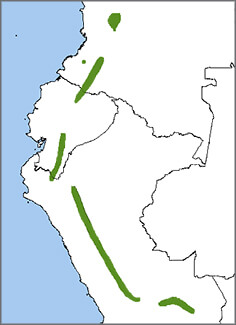 With a signature stripe of bright orange-yellow behind each of its eyes, the Golden-plumed Parakeet moves about the cloud forests of the high Andes in small, noisy flocks. Like the Yellow-eared Parrot, this bird nests in cavities in wax palm trees.
With a signature stripe of bright orange-yellow behind each of its eyes, the Golden-plumed Parakeet moves about the cloud forests of the high Andes in small, noisy flocks. Like the Yellow-eared Parrot, this bird nests in cavities in wax palm trees.
But the wax palm is at risk. For centuries, leaves of this tree have been used in great numbers for traditional Palm Sunday celebrations. ABC's Colombian partner, Fundación ProAves, has been working successfully to encourage celebrants to replace the wax palm with other tree species.
Podocarpus Parakeet
Golden-plumed Parakeets feed primarily on the seeds of Podocarpus oleifolius, a native conifer species, but also eat seeds and fruits from other trees in the cloud forest. Some populations of this parakeet travel widely each day: to the uplands to feed, and back again to the lower forests to roost.
Sign up for ABC's eNews to learn how you can help protect birds

Golden-plumed Parakeet at Tapichalaca, Ecuador. Photo by Ramiro Mendoza
Breeding seasons vary and are tied to food availability rather than a specific time of year. In their wax palm nests, holes made by other birds, or manmade nest boxes, the female lays two or three eggs. Both parents take turns incubating the eggs.
Ways to Save the Species
In addition to ProAves's campaign to replace wax palms in religious celebrations, ABC's partner in Ecuador, Fundación Jocotoco, is working to reduce the unsustainable harvest of this tree.
Meanwhile, both organizations are advancing the use of artificial nests to help save the Golden-plumed Parakeet. ProAves has developed an Artificial Nest Initiative as part of its Threatened Parrots Program, and Jocotoco has installed nest boxes in the Tapichalaca Reserve.
Donate to support ABC's conservation mission!



















































